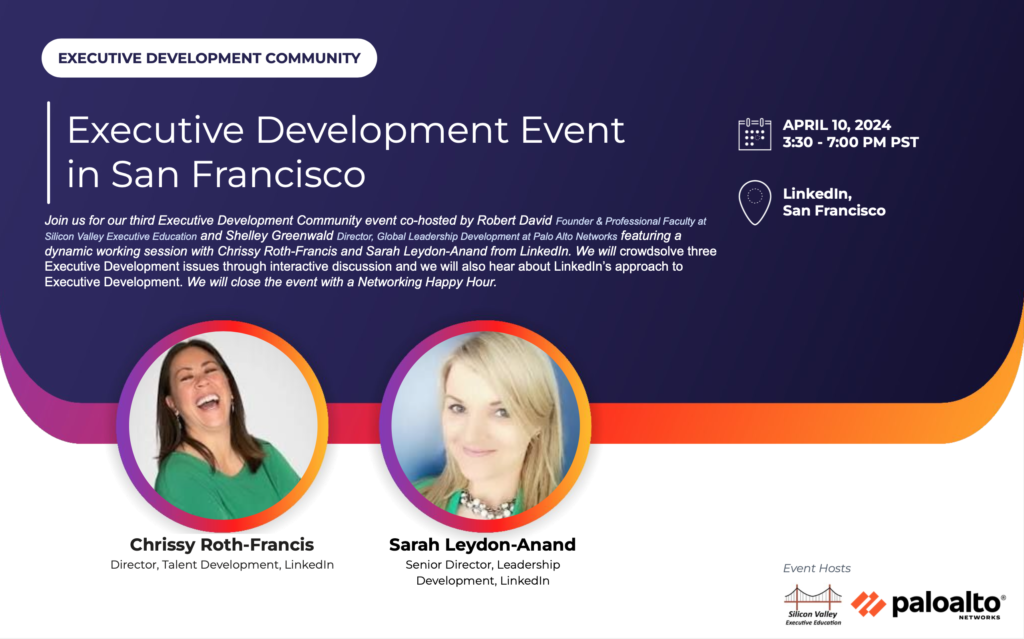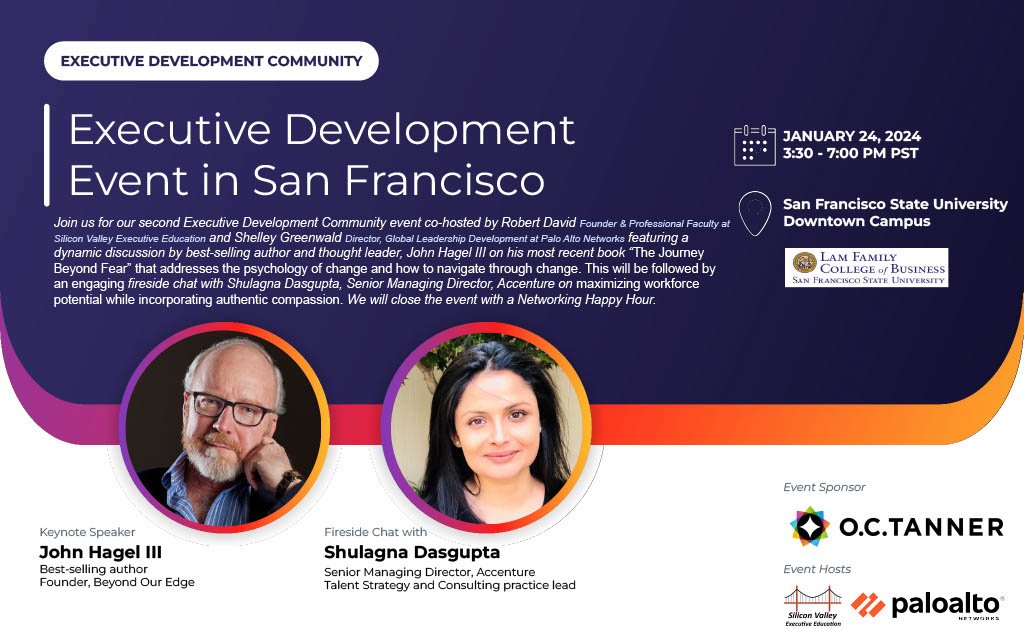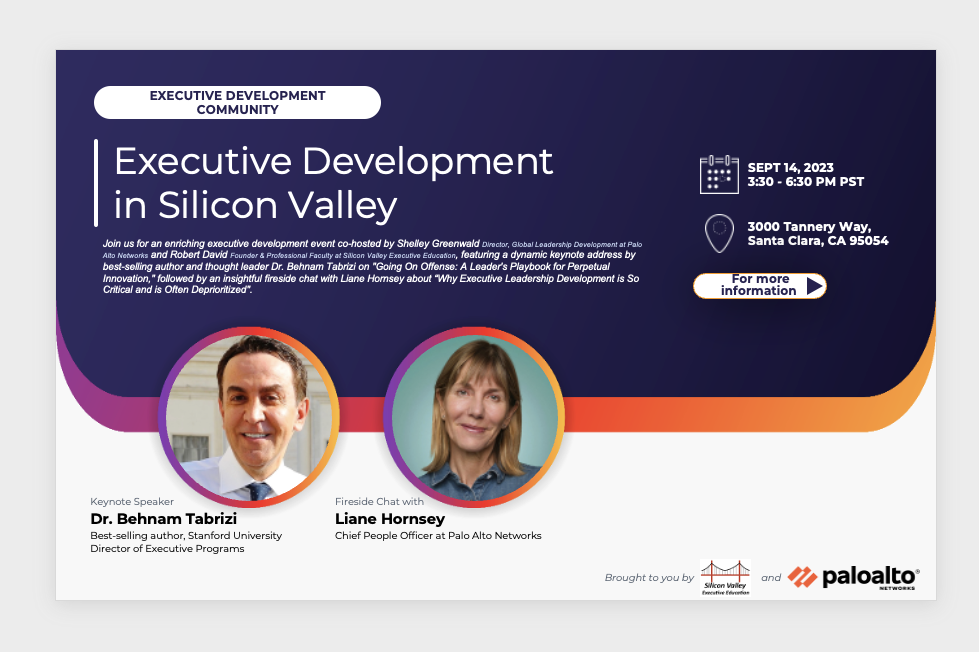




Our most recent article has been published on the SHRM Executive Network website this week. Which reason resonates most to you?
https://lnkd.in/gbGhVduj
“Persistent leadership starts at the top. Here are insights on how leaders can guide their teams toward extraordinary macro goals by staying present and purposeful at the micro level.”
hashtag#persistentleadership SHRM Executive Network hashtag#shrm hashtag#leadershipinsights
GOLD (“Gratitude Organizational Leadership Development”) is a program designed for improving Leadership Agility by combining the power of group peer work with individualized coaching. The program was crafted by experienced thought-leaders, from working with over 150 companies globally, conducted by The Gratitude Network in collaboration with Silicon Valley Executive Education.
Growing companies face many organizational and leadership challenges – just by the nature of growth. This program addresses these issues, drastically transforming leaders into ‘GOLD teams’, all while solidifying social responsibility and engaging employees in giving back.
Leadership Development
While many companies know that they need to find a way to continually develop their most significant leaders, they really have few options for doing this. Investing in leaders is one of the best investments a company can come given the positive ripple effects:
-Personal growth as a manager and leader
-Improved communications skills
-Increased sensitivity to diversity & inclusion
-Setting clear goals and expectations for employees
-Improved strategic planning
The GOLD Program is available to make this investment in the context of actual/current projects & challenges.
Top Leadership Retention
Retaining top leadership can be challenging for a variety of reasons:
-Competition
-Burnout / personal reasons
-Lack of growth opportunities / recognition
-Organizational culture
-Limited autonomy
The GOLD Program helps organizations retain their most valued leaders because it is viewed as a reward and privilege by the leaders who are chosen to participate in the program.
Increase Team Productivity
As a company grows, it can become more challenging to maintain the same level of productivity among teams.
-Complexity to navigate new resources
-Communication breakdowns
-Lack of clear goals and expectations
-Decrease in employee engagement
-Bureaucracy and red tape
The GOLD Program helps develop and maintain the high performance teams leading a company to success.
Organizational Silos
Siloed departments can happen for a number of reasons.
-Lack of communication and coordination
-Limited cross-functional collaboration
-Competition for resources
-Different cultures or incentives & rewards
-Limited leadership visibility & accountability
The GOLD Program will help with cross-functional leadership and lowering silos across departments
Lack of Inclusive Leadership
A lack of inclusive leadership can have a number of negative consequences for an organization.
-Lack of workforce diversity, which can negatively impact: Creativity & Innovation.
-Lack of engagement & retention of diverse employees.
-Culture of marginalization which will result in low morale & productivity
The GOLD Program will help with implementing DEI Initiatives
GOLD combines customized 1:1 leadership coaching AND monthly* group sessions for often siloed department leaders.
GOLD encourages immediate integration of skills with existing projects, programs & challenges.
GOLD allows you to cost-effectively retain & develop your most valuable leaders AND improve team-work & productivity throughout the organization.
The GOLD Program is different by combining 5 elements into leader & team growth:
-Customized 1:1 coaching to address individuals’ leadership needs
-Group process allows for Peer to Peer learning
-Group process tears down silos and create improved communication across organizations / departments
-Immediate integration with existing projects / programs and challenges
-Employee Engagement by applying leadership skills in your community
1:1 Social Impact is one of the best benefits of GOLD
For every employee enrolled in this program, The Gratitude Network offers a year of leadership training and one-on-one coaching to a deserving social impact entrepreneur.
In addition, choose the organization to direct the gift to within three categories (Education, Health and Well-being, and Human Rights) and in a variety of countries/regions.
EASY SET UP
C-suite sponsors (CEO / CHRO) choose 12 to 15 critical leaders from a company to participate in GOLD + Program length (6, 9 or 12 months)
Customize a program relevant to a company’s challenges thanks to GOLD’s carefully curated leadership modules. All participants learn together as peers in monthly facilitated group sessions.
We match one of our highly experienced executive Coaches to each of your chosen participants. Each participant receives monthly 1:1 coaching, which reinforces the group work and integrates with real time corporate projects and challenges.
PROGRAM COMPONENTS
-Pre-Assessment (360 assessment)
-Facilitated team learning modules (peer cohort)
-1:1 Coaching – once per month with highly qualified coach
-Quarterly check-ins with C-Suite sponsors
-Post-Assessment (to measure progress)
GOLD Customizable Modules
1. Building Trust & Emotional Intelligence
2. Highly Effective Leadership Coaching
3. Executive Presence
4. Building the High-Performance Team
5. Communication & Influence
6. Inclusive Leadership (DEI)
7. Developing a Culture of Accountability & Results
8. Creative Problem Solving and Innovation Management
9. Managing & Leading in a Changing Workplace
For more information, please contact [email protected].
https://hbsp.harvard.edu/inspiring-minds/making-vr-a-reality-in-business-classrooms
Lessons from INSEAD’s Executive Education Team
Put on a virtual reality (VR) headset, and you are immediately immersed in the sights and sounds of a retail showroom, a hotel front desk, or a tense boardroom negotiation—or, perhaps, transported to a state-of-the-art assembly line or a bustling city market miles away. For years, corporations such as Walmart and Hilton have explored the uses of VR technology in employee training, and we are now beginning to understand its potential for business classrooms and executive education. Questions remain: How does VR technology work in the business classroom and where does it fit into the future of online and in-person executive education?
Who should take this 1-day program?
CCABS is intended for organizations and teams with an interest in how climate change is impacting business, and how business sustainability depends both on mitigating climate impacts and on adaptation to ongoing climate change. While the program does not shy away from using scientific terms, the material is easily accessible, and no prior familiarity with climate science is assumed. The program examines a range of approaches to business sustainability in the context of a changing climate, the actions that business can take to improve the climate outlook, and the emergence of a climate-aware economy.
What is the focus of this course?
CCABS is an optimistic take on the daunting issue of climate change, and maps how business can play a definitive role in addressing the problem of climate change. In terms of balance, the program addresses the business implications of climate change (80% of the day) integrated with a bit of Climate Science for grounding (20% of the day).
What are the skills that this program is intended to develop?
Program summary
CCABS addresses a range of topics that cover the principal elements of how business is affected by climate change, and how changing business practices can improve (or worsen) the climate outlook.
For more details, email [email protected].
Source: https://www.linkedin.com/pulse/leader-why-you-should-let-others-lead-northwest-executive-education
Originally published on May 5, 2022
One of the most difficult tasks that leaders face is the ability to follow others. In the presence of a leader, businesses run smoothly. However, even if the leader is not present, the businesses should still be capable of performing well. To fully instill such effective leadership skills in peers, it is critical for leaders to delegate authority to others and let others lead, take charge, and decide what is and is not good for the organization. A capable leader will aid others in honing their professional skills. It also boosts the company’s productivity and, as a result, profitability. The role of a leader is to serve as a role model for employees, providing guidance, and encouraging employees to further their education and professional development. As a result, it is critical for leaders to comprehend why it is critical for them to let others lead.
Here are some compelling reasons why effective leadership necessitates delegation of authority:
Your coworkers look up to you not only as a leader but also as a role model. One of the most important responsibilities of leaders is to teach their peers about the importance of leadership and to instill leadership skills in them so that they are able to take responsibility. Allowing your team members to take the lead gives them firsthand experience with what the responsibility entails and what is expected of the holder. This assists your peers in growing and improving their performance by providing them with a practical approach to workplace challenges.
Aspiring for a higher position is common among employees. What is frequently overlooked, however, is that a higher authority brings along increased responsibilities. To let others lead means giving them firsthand experience of the responsibilities that come with a higher position. This allows employees to rethink their capabilities and identify areas where they need to improve in order to be effective in the role they aspire to fill and work on themselves accordingly.
Delegation is important not only because it is a part of effective leadership, but it is also important for increasing employee contributions and increasing team productivity. Delegation promotes time management and ensures that tasks are completed on time. Everyone has their own area of expertise, and it is true that putting one person in charge of a job that requires a specific skill makes the task easier; therefore, delegation is critical. Individuals are empowered by delegation because it allows them to demonstrate their ability to take on new responsibilities. It encourages people to feel more committed and involved by allowing them to see what contributions they have made to the team. As a result, leaders must delegate authority to peers and let others lead.
Aside from getting all of the work done, one of the most important responsibilities of leaders is to create a positive working environment for their employees that allows them to easily achieve their professional and personal goals. Instead of relying on their leaders and managers for help, it is critical that team members feel empowered to solve the day-to-day problems that arise in their current positions. This increases their self-assurance, knowledge, and problem-solving skills, all of which will be important when they take on a leadership role. You can successfully support your team members’ personal growth by providing lessons and space for them to develop personally, developing a culture of working together and cooperating.
Giving your coworkers responsibility is the most effective way to recognize their unique strengths and abilities to solve problems. Everyone approaches challenges differently, which is how leaders learn which domains an individual excels in and which domains they struggle with. It is critical to get to know your team in order to effectively lead them; thus, if you let others lead and delegate authority to deal with situations, you will improve their efficiency.
It can be difficult to relinquish a leadership position and move on, but it is necessary for the team or individuals you are mentoring to progress. The aforementioned reasons demonstrate why it is critical for leaders to relinquish control of their authority from time to time and let others lead, allowing peers to learn and grow.
Northwest Executive Education delivers comprehensive global executive education programs offered by the world’s best universities.

In the post-COVID era, it’s common practice to say certain things are “more important than ever before.”
And common as the saying may be, the sentiment is absolutely correct.
Family. Wellness. Mental health. Governance. Supply chains. Corporate resilience. All these have revealed themselves to be even more critical to our collective survival than we ever thought possible.
The same can be said for business leadership.
Even as the ground shifts beneath us and antiquated notions of “work before wellbeing” fall away, executive leaders still have a crucial role to play in guiding employees and refining organizational skillsets. C-suite leaders, including CEOs, COOs, CHROs, CTOs, and beyond, can still exert tremendous positive influence, helping to further develop sales and optimize daily processes overall.
They just have to start thinking a little differently.
Below are three best leadership practices that can encourage better sales results and help promote a healthier company culture in the post-pandemic age.
Not much is certain in 2022, but here’s one thing that’s become abundantly clear:
The notion of the executive ivory tower is now completely outdated.
In our current landscape, business ideology has transformed from “top down” to “fire up,” meaning leadership is no longer a matter of influencing from above, but rather inspiring from within. This requires leaders to break down traditional hierarchies, take an active interest in everyday processes, and get in the weeds with their sales managers as well as other revenue-facing team members.
Indeed, Stark and Associates President and CEO, Suzie Andrews, a sales and leadership development specialist, recommends company leaders venture “out in the field” with their salespeople to get an accurate reading on the state of business affairs; demonstrate a compassionate interest in team members’ personal aspirations; formulate plans for growth; and provide invaluable support to representatives on the ground.[1]
Bridging the C-suite-to-sales-team gap in this way is key, if only because conventional corporate ladders can seriously stifle leadership success. In fact, Jeffrey Pfeffer, Professor of Organizational Behavior at Stanford Graduate School of Business, warns of a troubling disconnect between old-school leadership “dogma”––which ostensibly relies on theory––and the practical applications of real-world experience.[2]
It’s an idea echoed by Nitin Rakesh, CEO and Managing Director of Mphasis, who notes:
“Leadership, in my view, is a contact sport––if company leaders are out in the field with clients and partners, proactively creating opportunities, as well as synthesizing trends, it becomes part of the firm’s fabric and enhances [the] competitive moat.”
Note: The operative word here is “proactively.”
When leaders log hours in the field (engaging with reps, speaking to clients, shadowing calls, etc.), they’re able to take a proactive approach to their business. They can gauge what’s working and what isn’t, highlight areas for improvement, and inspire teammates on more immediate terms. And perhaps most importantly, they can prepare for next steps to help propel the company forward.
Such active participation at the C-suite level can light a proverbial fire for employees, inciting them to develop an “owner’s mindset” (as described in Zook and Allen’s The Founder’s Mentality[3]), chasing their professional goals as if there were something much more personal at stake.
In other words: Proactive involvement from C-level executives can inspire a company-wide push toward more wins and greater impact.
If you’re hoping to inspire with a proactive spirit, however, you can’t limit yourself to only one or two spheres of influence.
Instead, you should seek to offer guidance and support from a variety of angles, including technical training, behavioral modeling, narrative strategy, and in-the-trenches engagement.
You should also make sure this multifaceted approach speaks to as many employees as possible, meaning your methods should take different learning styles and sensibilities into account at all times.
This concept is underlined by Debbie Lawley, CEO of leading UK e-learning company, WillowDNA, who notes that sales––and, by extension, sales leadership and development activities––reflect “a combination of multiple competences,” covering everything from selling techniques to product knowledge and systems deployment. Lawley adds:
“The reach of [learning and development] has to be broad enough to cover all these areas… Blended learning programmes bringing together experts, stories, competitor knowledge as well as systems and sales support are key to impactful outcomes.”[4]
Your reach as a leader should be similarly broad in scope, harnessing the collective powers and experience of all C-suite players to motivate activities both behind the scenes and out in the consumer-facing market.
Some examples of this kind of multi-layered outreach can include:
With that last point in mind, consider both Lawley and Pfeffer, two out of four experts cited here, express real concerns about today’s educational modalities.
To recap:
Pfeffer fears leadership development is too narrowly focused on conventional ideas of what leaders are “supposed to do,” where it should instead focus on applied, real-world experience.
Meanwhile, Lawley cautions that sales L&D programs aren’t comprehensive enough to produce well-rounded salespeople (or sales managers) who possess both the knowledge and techniques that are necessary to succeed.
If we take Lawley and Pfeffer to heart, we can safely assume corporate learning––for leaders, managers, and salespeople alike––is falling short. Leaders are held back by abstract theories of what constitutes effective leadership, while managers and “lower-level” employees lack the holistic tools they need to refine their skills and secure more deals.
Still, there’s hope.
Newer, savvier models are emerging. Marked by out-of-the-box thinking and fueled by hands-on learning, these systems leverage current social and technological trends to break traditional constraints and empower innovative action at every turn. They feature:
A contextualized approach that addresses the various needs of each individual “student,” while tailoring lesson plans to the express requirements of each new business challenge. Such plans incorporate digital learning tools like virtual simulation as well as interactive, real-world-scenario testing.
A results-based curriculum that drives learners toward concrete victories rather than wasting time on purely theoretical materials that don’t factor into everyday sales/sales leadership activity. This curriculum looks to recent findings on the benefits of micro-learning, engaging “bite-sized” learning sessions for maximum retention.[6]
A pared-down model that respects the modern workday schedule, streamlining programs to work with leaders and employees, not against them. These learning systems take advantage of on-demand services such as online courses and offer compact, scalable lessons (in the form of webinars, graphics, etc.) to help hone company-wide skills.
Armed with these three strategies, leaders can expand their spheres of influence and help maintain a culture of proactivity without resorting to older, hierarchical methods that can sow division and slow company growth.
Or, put another way:
“…If one is able to look around corners and anticipate the shifting trends and make some bold big bets early on, it may be possible for teams to construct proactive wins in situations where you are able to get a seat at the table …” – Nitin Rakesh
In the wake of COVID, the need for inspiring leadership hasn’t disappeared: it’s merely changed shape. Your ability to redefine with the times will help secure the ongoing success of your business––at a moment where longevity and sustainability are more important than ever before.
[1] https://blog.hubspot.com/sales/modern-sales-leader
[2] https://www.theceomagazine.com/business/management-leadership/time-to-rethink-traditional-learning-and-development/
[3] https://www.bain.com/founders-mentality/book/
[4] https://www.willowdna.com/learning-development-sales-ceo-insights/
[5] https://hbr.org/2018/03/how-we-made-our-sales-training-more-effective-by-making-it-harder
[6] https://rpsblog.raytr.com/micro-learning-game-changer-digital-age/